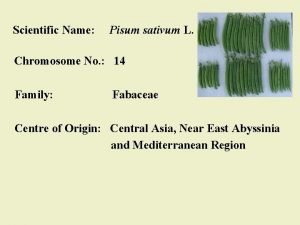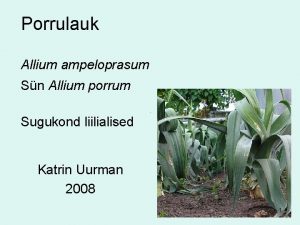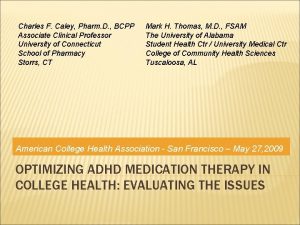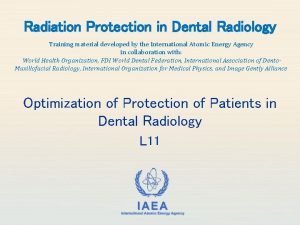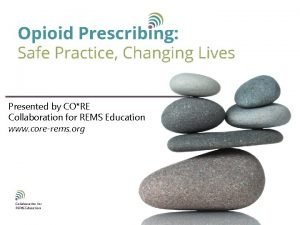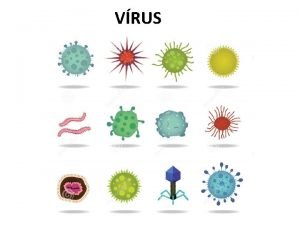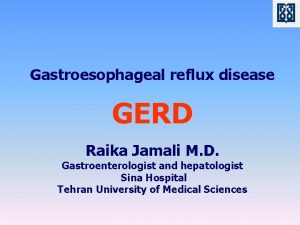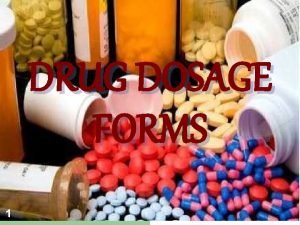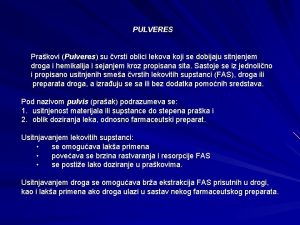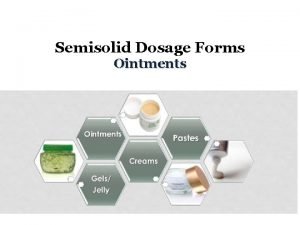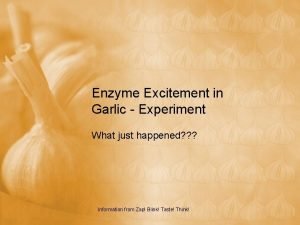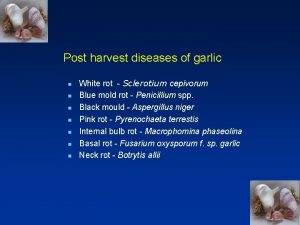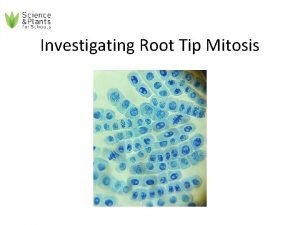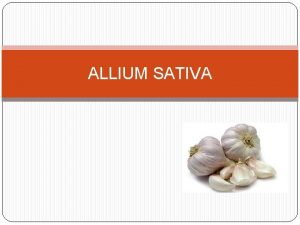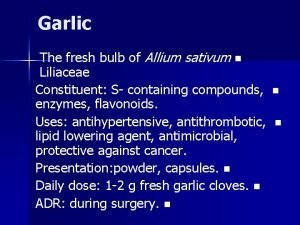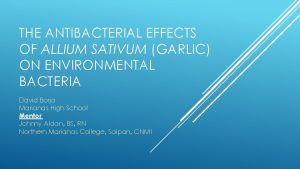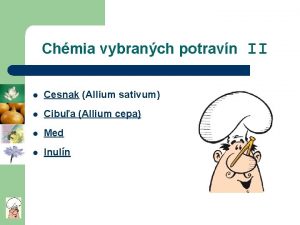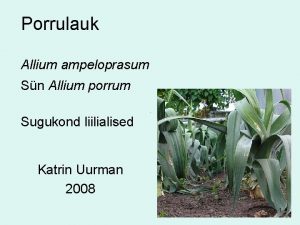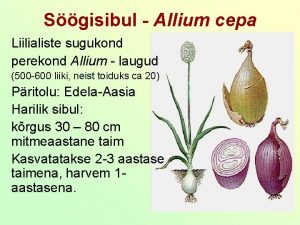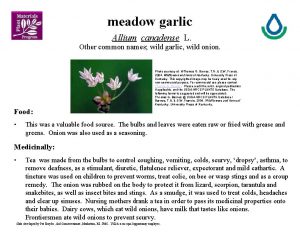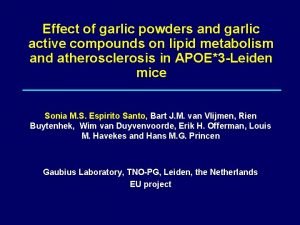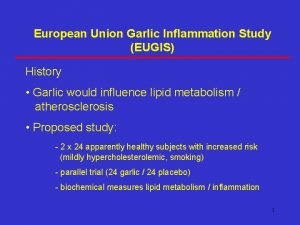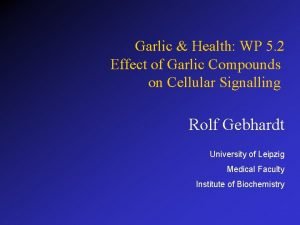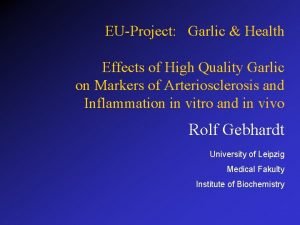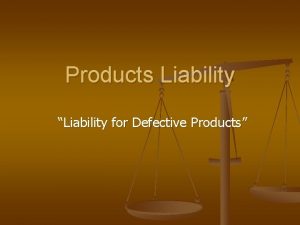Lecture 2 Garlic Allium Sativum Products description Doses


























- Slides: 26

Lecture 2 Garlic (Allium Sativum) • Products description • Doses • Toxicity


Top Supplements Used by US Households in 1997 Of 91 herbal supplements, garlic was found to be used more than twice as much as other supplements.

Intake of Garlic? • The appropriate amount is yet to be determined • The German Kommission E monograph (1988) proposed a daily intake of ~1 -2 cloves of garlic or ~4 g of intact garlic per day for health benefits • However, there was no scientific evidence to back this recommendation.

Garlic supplements • Essential oil • Dehydrated powder • Oil macerate • Extract PBRC 7/05 5

Essential Oil PBRC • Garlic oil is typically prepared using steam distillation, whereby crushed garlic is steamed with the resultant condensation containing the oil • Steam-distilled garlic oil typically has a pungent odor and a yellow-brownish coloration • The essential oil content of garlic cloves is 0. 2 -0. 5% and consists of a variety of sulfides. • Its odor has been attributed to the presence of diallyl disulfide • To produce around 1 g of pure steam-distilled garlic oil, around 500 g garlic is required. • Steam-distilled garlic oil has around 900 times the strength of fresh garlic, and around 200 times the strength of dehydrated garlic • Commercially available garlic oil capsules generally 7/05 small amount of garlic contain vegetable oil and a 6

Dehydrated Powder • Garlic powder is mass-produced as a flavoring agent for condiments and processed foods. • Garlic cloves are sliced or crushed, dried and pulverized into powder. • Garlic powder is thought to retain the same ingredients as raw garlic; however, the proportions and amounts of various constituents differ significantly. PBRC 7/05 7

Oil Macerate • Oil macerates were originally developed for use as condiments. • Oil macerate products are made of encapsulated mixtures of whole garlic cloves ground into vegetable oil. PBRC 7/05 8

Extract • For garlic extract, whole or sliced garlic cloves are soaked in an extracting solution (purified water and diluted alcohol) for varying amounts of time. • After separation of the solution, the extract is generally concentrated and used. • Powdered forms of the extract are also available. PBRC • The extract, especially AGE, contains mainly the water-soluble 7/05 constituents 9

Aged Garlic Extract • As the name implies, this extract is aged for up to 20 months. • Over this time, the harsh and irritating compounds in garlic are converted naturally into stable and safe sulfur compounds. • Aged garlic extract contains primarily water-soluble sulfur compounds such as SAC and SAMC (S-allylcysteine (SAC) and S-allylmercapto-cysteine), as well as a variety of oil-soluble sulfur compounds. • The safety of AGE has been confirmed by various toxicological studies. PBRC 7/05 10

Bioavailability of garlic compounds • SAC is one of the water-soluble organosulfur compounds in garlic, whose concentration can be detected in the plasma, liver, and kidney after oral intake. • Its concentration increases during extraction/aging. • The pharmokinetics of SAC are well-established. • Its bioavailability in mice is 100. 0%, in rats 98. 2%, and in dogs 87. 2%. PBRC 7/05 11

• From several studies, SAC has proven to be a stable, odorless, water-soluble compound with the ability to lower cholesterol, serve as an antioxidant, inhibit the cancer process, and protect the liver from toxins. • AGE has shown cholesterol-lowering effects in several clinical studies • At present, SAC is the only reliable human compliance marker used for studies involving garlic consumption because it is detectable and increases quantitatively in the blood after oral intake of garlic capsules. PBRC 7/05 12




• The oil-soluble organosulfur compounds in garlic, including allicin, sulfides, ajoene, and vinyldithiins are not found in the blood or urine after garlic consumption. • They are not likely to be the active compounds. • The instability and/or metabolism of such compounds likely contribute to the inconsistent results found in the clinical cholesterol studies using garlic oil and garlic powder products. 7/05 PBRC 16

Safety Issues • Prevention, rather than in therapy, is where the effectiveness of garlic probably lies • However, to obtain the preventative benefits of garlic, long-term supplementation may be necessary PBRC 7/05 17

Safety Issues • Although garlic has been used safely in cooking as a popular condiment or flavoring and used traditionally for medicinal purposes, it is commonly known that excessive consumption of garlic can cause problems. • Garlic odor on breath and skin and occasional allergic reactions are recognized. PBRC 7/05 18

• Reports since 1932 have revealed the following adverse effects associated with raw garlic and garlic powder: • • • PBRC Stomach disorders and diarrhea Decrease of serum protein and calcium Anemia Bronchial asthma Contact dermatitis Inhibition of spermatogenesis 7/05 19

• Oil-soluble sulfur compounds are known irritants and allergens • Topically applied diallyl-sulfide (DAS) is the most allergenic • The following toxicity effects of garlic were reported in 1990: • Allicin is one of the major irritants in raw garlic • Oil soluble sulfur compounds are more toxic than water -soluble • When garlic is extracted in a certain period, its toxicity is greatly reduced PBRC 7/05 20

• On the other hand, the safety of AGE has been well established by the following studies: • • PBRC Acute and subacute toxicity tests Chronic toxicity tests Mutagenicity tests General toxicity tests Teratogenicity tests Toxicity tests conducted by the USDA Clinical studies conducted on >1000 subjects 7/05 21

SAC versus DADS • The United States National Cancer Institute tested the toxicity of SAC vs. other typical garlic compounds and found that it has a 30 -fold less toxicity than allicin and diallyl-disulfide (DADS) PBRC The 50% lethal oral dose for each in mg/kg body weight Allici DAD SAC n S Male 309 Female 363 7/05 145 130 8890 9390 22

• The Globally Harmonized System (GHS), defines it as "those adverse ef fects occurring following oral or dermal administration of a single dos e of a substance, or multiple doses given within 24 hours, or an inhala tion exposure of 4 hours" • The preferred species for oral and inhalation testing is the rat, and for dermal testing, the rat or rabbit • Oral administration is the most common form of acute systemic toxici ty testing.

• ALLERGENICITY/HYPERSENSITIVITY TOXICOLOGY STUDIES �Guinea Pig Maximization test �Local lymph node assay �Determination of Maximum non irritant or minimum irritant dose �Evaluation of Erythema and oedema �Mice of one sex(either male or female) �Drug treatment given on ear skin �Auricular lymph node dissection after 5 days �Increase in 3 h-thymidine used for evaluation • GENOTOXICITY STUDIES �To detect early tumorigenic effects in cases of chronic illness �In vitro tests: �Test for gene mutation in Bacteria �Cytogenetic evaluation of chromosomal damage in mammalian cells E. g. ; Ames’s Salmonella Assay detects increased number of aberrations in metaphase chromosomes �DNA strand breaks, DNA repair or recombination, Measurements of DNA adducts

• IN VIVO TESTS � In vivo test for chromosomal damage using mammalian hematopoietic cells. � Chromosome damage in rodent hematopoietic cells E. g. ; Micronucleus Assay • CARCINOGENICITY/ ONCOGENICITY STUDIES �life-time bioassays �carcinogenicity studies are performed on: �drug used for >6 months or frequent intermittent use for chronic diseases �chemical structure of drug indicates carcinogenic potential �therapeutic class of drugs which have produced positive carcinogenicity. • NOTE ON STEM CELLS NOW EMERGING AS AN ALTERNATIVE TO LABORATORY ANIMALS Drug company interest in stem cell drug testing was demonstrated in July 2008, when Glaxo. Smith. Kline entered into a $25 million-plus agreement with the Harvard Stem Cell Institute. By testing drugs on specific cells and tissues created from i. PS cells, we can even predict a patients individual response to a treatment realizing the vision of personalized medicine. In the current issue of Stem Cells and Development (2007), Cezar and her colleagues revealed a novel way to test drug toxicity: by monitoring the behaviour of embryonic stem cells exposed to a drugcandidate compound. Studying how potential drugs affect embryonic stem cells could provide a far more accurate prediction of a drug's potential toxicity than conventional animal models can. Currently, the most successful development of stem cells as in vitro models for toxicology testing is in human cardiac tissue.

• The Ames test is a widely employed method that uses bacteria to test whether a given chemical can cause mutations in the DNA of the test organism. . A positive test indicates that the chemical is mutagenic and therefore may act as a carcinogen, because cancer is often linked to mutation.
 Chromosome number of clove
Chromosome number of clove Economic importance of chickpea
Economic importance of chickpea Allium ampeloprasum
Allium ampeloprasum Allium cepa habitat
Allium cepa habitat Allium nevskianum
Allium nevskianum Adderall dosage by weight
Adderall dosage by weight Monophasic liquid dosage form list
Monophasic liquid dosage form list Canthomeatal line
Canthomeatal line Belbuca doses
Belbuca doses Vacina sarampo quantas doses
Vacina sarampo quantas doses Ambalism
Ambalism Ppi equivalent doses
Ppi equivalent doses Liquid dosage forms examples
Liquid dosage forms examples Botox dosage forehead
Botox dosage forehead Pulveras
Pulveras Amoxicillin peds dosing chart
Amoxicillin peds dosing chart Oleaginous base examples
Oleaginous base examples Concerta dosing
Concerta dosing 01:640:244 lecture notes - lecture 15: plat, idah, farad
01:640:244 lecture notes - lecture 15: plat, idah, farad Some any lesson
Some any lesson Allacin
Allacin Where did garlic come from in the columbian exchange
Where did garlic come from in the columbian exchange Sendayu tinggi sabah
Sendayu tinggi sabah Leaf riddle
Leaf riddle Causal organism of neck and bulb rot in garlic is _____
Causal organism of neck and bulb rot in garlic is _____ Garlic columbian exchange
Garlic columbian exchange Cells
Cells

